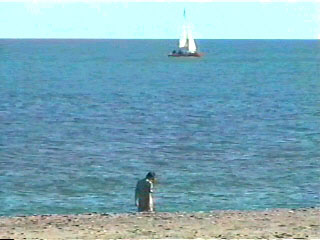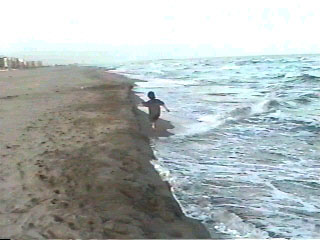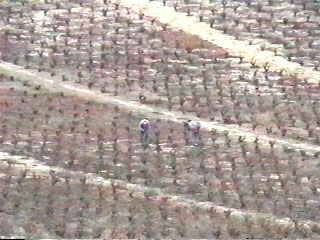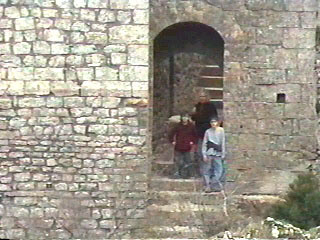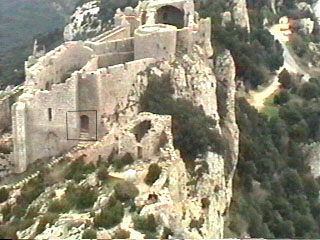Canet En Rousillon
December, 2000
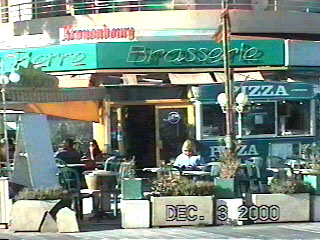 |
Our next destination was Canet En Rousillon, a small
beach community near the larger city of Perpignan, close to the border
dividing France and Spain.
There are many small beach communities along the Mediterranean
in Southern France near Spain. This restaurant was one of several in Canet
En Rousillon along the beach It's a small resort community
but many of its restaurants and shops were closed for the season.
The street and a wide sidewalk is all that separates the shops from the
beach.
|
This is the restaurant I mentioned before where the large
dog freely walked around the tables. It's just something you have
to get used to. Don't expect to see any "no smoking" sections either.
Mitch and Max had fun playing on the beach as we enjoyed
lunch and a glass of wine. The game in the picture on the right was
to run along a thirty foot long, two foot high cliff of sand without getting
wet by the surf that occasionally splashed over the top.
Speaking of wine, French prices were great! If you
are thirsty and don't have very much money, bottled water is usually the
most expensive, followed by soda pop; (a Coke or Pepsi -- usually only
a 10 oz. bottle -- is more than beer.) A glass of house wine at a
restaurant is very reasonably priced. At a large French grocery store
chain named Casino, I planned to buy a good bottle of French champagne,
(just to see if it was really a lot better than the types we buy in the
US.) I saw bottles ranging from the US equivalent of $3.00 to $80.00.
Hmmm, which one to buy? Then I spotted a bottle for 7 Francs, (that
is 1 US dollar.) I bought it and another for the equivalent of 15
US dollars. I must admit, they were both very good and very close
in quality.
We stayed at a condo in this little resort town for a
week. It was located in a beautiful, historic area so we made several
day trips.
Carcassonne, France
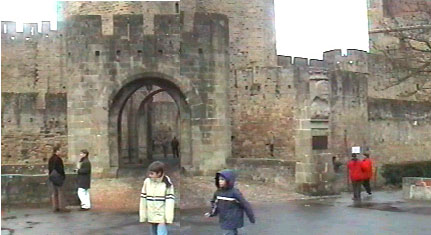 |
When we pulled up to these walls the boys both groaned
... "oh no, another castle." But when we walked through the gates
they both shouted "COOL" and took off running.
This place is called Carcassonne and is considered to
be Europe's greatest walled city. Built about 800 A.D., this city-within-a-fort
still contains a thriving community. Of course the main industry
is tourism, but this town includes full-time residents and businesses including
an active church.
|
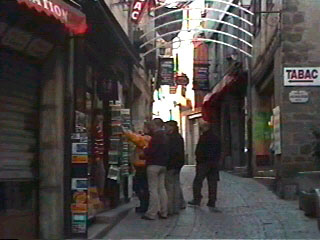 |
I'm glad we were there during the off season. It
appeared much like a town without the flood of summer tourists to pack
the streets. Cars, either locals going about their business or delivery
trucks occasionally made their way through the narrow streets. |
The next photo was taken inside of the city walls -- it is
the Castle of Carcassonne. Carcassonne has a fascinating history.
As legend goes, the army of Charlemagne was determined to force the locals
out. They had laid siege to the city for years, determined to starve
the people out from behind those walls.
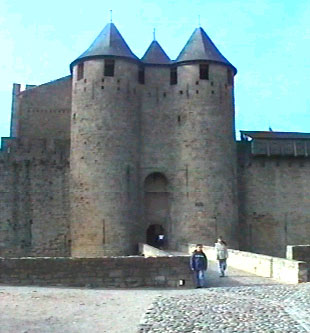 |
It wasn't easy though, it was taking years and
the army were getting restless and bored. Meanwhile, inside the city
walls, the residents were getting desperately low on food and were thinking
about surrendering. A very smart lady named Madame Carcas fed the
last bits of grain to the very last pig in town and then tossed the pig
over the wall. Splat! Well, Charlemagne's army saw that and
figured that if these people still had this much food left, they'd never
get them out. The army left and the city was saved. The happy
residents decided to name the city after Madame Carcas. |
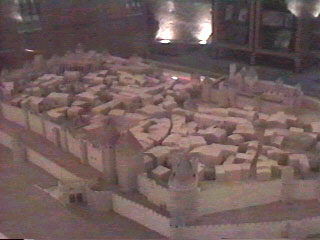 |
This is a model of Carcassonne. The entrance is
between the two turrets on the lower left across a moat. The castle
sits in the rear, near the upper right and the church is in the back near
the upper left. Across the moat is the first wall of defense which
is taller than it looks in this picture. The fortress could be defended
from casual attacks from this outer perimeter and, if necessary, occupants
could pull back into the inner walls which were over thirty feet high and
quite thick. |
As a third level of defense, the inner castle had it's own
moat and protective walls as seen in the photo above this one.
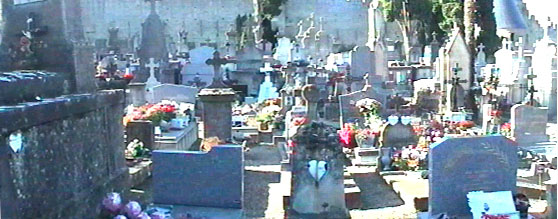
Just outside of the entrance to Carcassonne was this very
beautiful cemetery. The dates ranged from the 1600's to 2000. As
you can probably tell it was very crowded with most of the large tombs
being multi-generational family crypts. It was really interesting
because almost all of the dates after 1900 had a photograph of the deceased
person, (when they were alive,) mounted on the headstone. One
crypt was so old that the corner of the rock and mortar had crumbled away.
Mitch peeked in for a look ... it was kind of spooky.
This spectacular stained glass must have been twenty-five
feet across or more. It was inside of an extemely old church inside of
the walls of Carcassonne. These places don't charge tourists anything
to come in, but there is usually a local near the door asking for a donation
to help save the crumbling church.
Driving through this part of Southern France, we passed
many vineyards and thousands of acres of grape vines, (photo above, right.)
The only workers we'd see is a few men out maintaining the plants.
Smoke rose from small fires as they burned vines trimmed from the plants.
We assumed that the white powder around the vines was lime.
 |
When I took this picture I told Max it would be one of
those he could hide from his girl friend when he's sixteen. |
Peyrepertuse
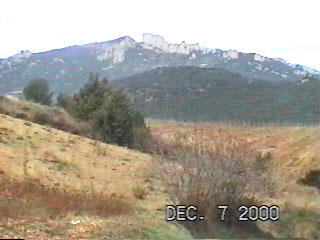 |
From a distance it looked like jagged rocks on the face
of the mountain top. As we drove closer we could see right angles
and we realized it included castle walls. We could see several of
these mountain top structures in the Pyrenees Mountains |
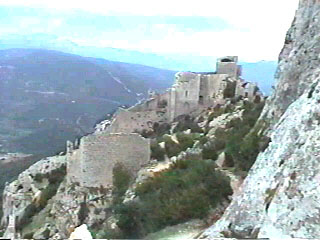
Pretty cool
|
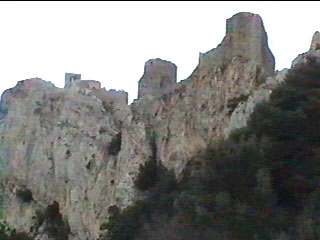
A view of the sheer walls from the parking area
|
The picture on the left is from the doorway seen in the picture
on the right. The second picture was taken from the top the chapel
seen in the pictures below.
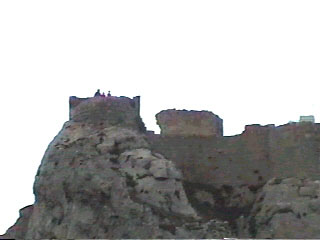 |
The Pyrenees Mountains have made a natural border between
Spain and France for centuries. With the addition of several fortresses
like Peyrepertuse spread in a line across the highest ridges, any invading
force could be easily seen. From the top of Peyrepertuse you could
see far off in the distance atop another mountain another fortress just
like the one we were standing in. All of these fortresses were built
within eye sight of each other, assuring that no one would be able to approach
unnoticed. |
The weapons of the times certainly had no range to defend
from above or attack from below. The fortress walls blend together
with the mountain. One side is straight down -- it goes for hundreds
of feet. The other side is passable but very steep. The sheer
ruggedness of the Pyrenees Mountains provided most of the defense against
invaders.
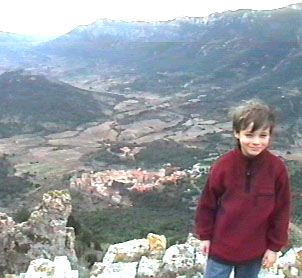 |
Below is the town of Duilhac, France. I remember
standing up on the edge of the castle wall so that I could get a picture
looking down on the town. To my right is a sheer drop of at least
400 feet -- at that point you'd bounce off of the first rock and then tumble
several hundred feet more. |
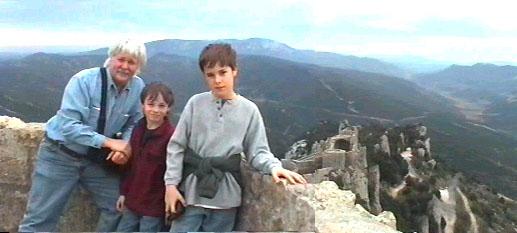
You can't see the town in this picture because Cheryl
refused to climb up onto the wall.
(Note from Cheryl -- I thought the boys might like having
their mom around for a few more years.)
ã
copyright Nodland 1999-2020

